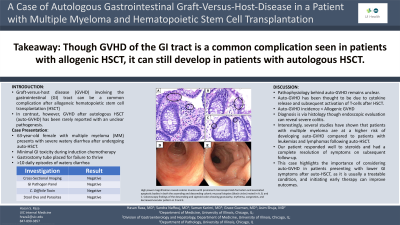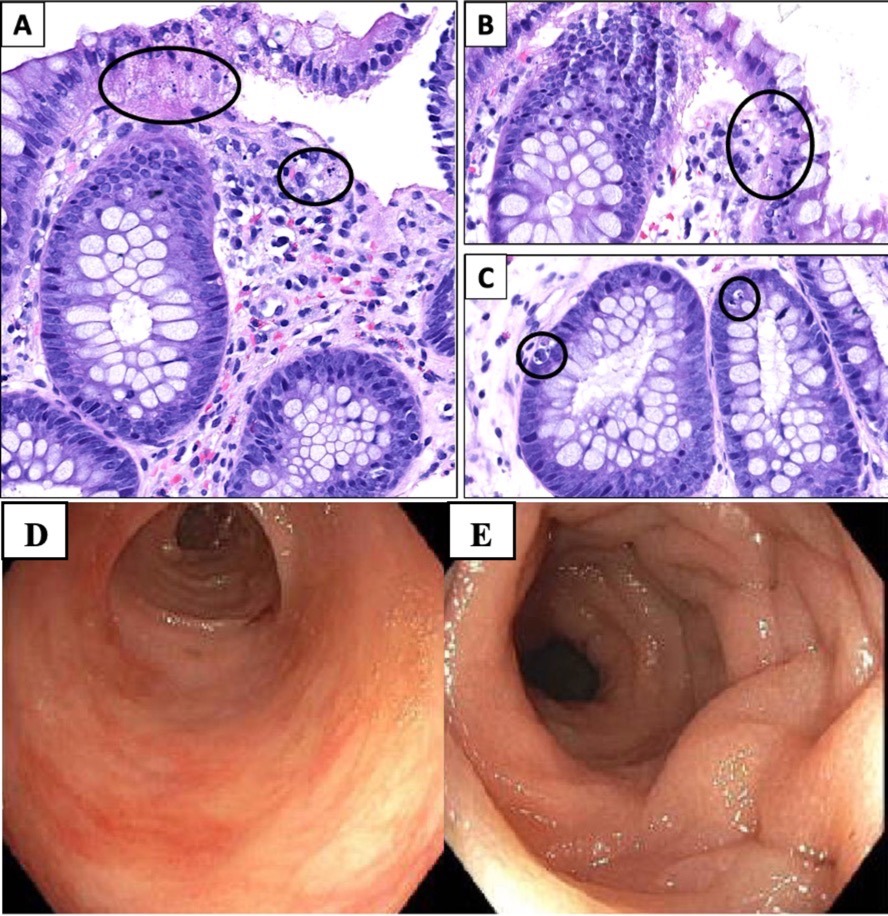Monday Poster Session
Category: Colon
P1667 - A Case of Autologous Gastrointestinal Graft-Versus-Host Disease in a Patient With Multiple Myeloma and Hematopoietic Stem Cell Transplantation
Monday, October 23, 2023
10:30 AM - 4:15 PM PT
Location: Exhibit Hall

Has Audio
- HR
Hasan S. Raza, MD
University of Illinois Chicago
Chicago, IL
Presenting Author(s)
Hasan Raza, MD1, Sandra Naffouj, MD2, Saman Karimi, MD, MS3, Grace Guzman, MD4, Asim Shuja, MD1
1University of Illinois Chicago, Chicago, IL; 2University of Illinois at Chicago, Chicago, IL; 3UIC, Chicago, IL; 4University of Illinois at Chicago, College of Medicine, Chicago, IL
Introduction: Graft-versus-host disease (GVHD) involving the gastrointestinal (GI) tract is a common complication after allogeneic hematopoietic stem cell transplantation (HSCT), attributed to the release of cytokines and activation of donor’s T cells causing inflammation and damage in different tissues. In contrast, GVHD after autologous HSCT (auto-GVHD) has been rarely reported, and its pathogenesis remains unclear. We present a case of auto-GVHD of the GI tract in a patient who received auto-HSCT and responded well to corticosteroids.
Case Description/Methods: A 63-year-old woman with multiple myeloma (MM) presented for auto-HSCT after ten months of induction chemotherapy with minimal associated GI toxicity. She had progressive failure to thrive and upper GI symptoms, including nausea and vomiting, which required endoscopic placement of a gastrostomy tube (G-tube) without significant mucosal abnormalities on esophagogastroduodenoscopy (EGD). She then developed severe watery diarrhea with >10 bowel movements per day. Comprehensive infectious work-up, including stool studies for GI pathogens, was negative. Computerized tomography (CT) of the abdomen showed no significant abnormalities. On day 50 post auto-HSCT, colonoscopy and biopsies showed findings consistent with GVHD of the colon. She was subsequently treated with high-dose IV steroids followed by a slow taper with resolution of symptoms. She was then discharged home and continued to do well on her 3-month follow-up off steroids.
Discussion: The mechanism for auto-GVHD remains unclear. One theory suggests auto-GVHD is part of the engraftment syndrome that occurs after HSCT resulting in cytokine release and activation of reactive T cells, causing infiltration of certain tissues like the GI tract. Auto-GVHD incidence has been reported to be much less than allogenic GVHD, with upper GI symptoms being the most common presenting symptoms, followed by diarrhea. Endoscopic findings range from normal to severe colitis, and diagnosis is based on histology. Interestingly, several studies have shown that patients with MM are at a higher risk of developing auto-GVHD compared to patients with leukemias and lymphomas following auto-HSCT. Our patient had a complete resolution of symptoms on steroids. This case emphasizes the importance of considering auto-GVHD in patients presenting with GI symptoms after auto-HSCT, as it is usually a treatable condition, and initiating early therapy can improve outcomes.

Disclosures:
Hasan Raza, MD1, Sandra Naffouj, MD2, Saman Karimi, MD, MS3, Grace Guzman, MD4, Asim Shuja, MD1. P1667 - A Case of Autologous Gastrointestinal Graft-Versus-Host Disease in a Patient With Multiple Myeloma and Hematopoietic Stem Cell Transplantation, ACG 2023 Annual Scientific Meeting Abstracts. Vancouver, BC, Canada: American College of Gastroenterology.
1University of Illinois Chicago, Chicago, IL; 2University of Illinois at Chicago, Chicago, IL; 3UIC, Chicago, IL; 4University of Illinois at Chicago, College of Medicine, Chicago, IL
Introduction: Graft-versus-host disease (GVHD) involving the gastrointestinal (GI) tract is a common complication after allogeneic hematopoietic stem cell transplantation (HSCT), attributed to the release of cytokines and activation of donor’s T cells causing inflammation and damage in different tissues. In contrast, GVHD after autologous HSCT (auto-GVHD) has been rarely reported, and its pathogenesis remains unclear. We present a case of auto-GVHD of the GI tract in a patient who received auto-HSCT and responded well to corticosteroids.
Case Description/Methods: A 63-year-old woman with multiple myeloma (MM) presented for auto-HSCT after ten months of induction chemotherapy with minimal associated GI toxicity. She had progressive failure to thrive and upper GI symptoms, including nausea and vomiting, which required endoscopic placement of a gastrostomy tube (G-tube) without significant mucosal abnormalities on esophagogastroduodenoscopy (EGD). She then developed severe watery diarrhea with >10 bowel movements per day. Comprehensive infectious work-up, including stool studies for GI pathogens, was negative. Computerized tomography (CT) of the abdomen showed no significant abnormalities. On day 50 post auto-HSCT, colonoscopy and biopsies showed findings consistent with GVHD of the colon. She was subsequently treated with high-dose IV steroids followed by a slow taper with resolution of symptoms. She was then discharged home and continued to do well on her 3-month follow-up off steroids.
Discussion: The mechanism for auto-GVHD remains unclear. One theory suggests auto-GVHD is part of the engraftment syndrome that occurs after HSCT resulting in cytokine release and activation of reactive T cells, causing infiltration of certain tissues like the GI tract. Auto-GVHD incidence has been reported to be much less than allogenic GVHD, with upper GI symptoms being the most common presenting symptoms, followed by diarrhea. Endoscopic findings range from normal to severe colitis, and diagnosis is based on histology. Interestingly, several studies have shown that patients with MM are at a higher risk of developing auto-GVHD compared to patients with leukemias and lymphomas following auto-HSCT. Our patient had a complete resolution of symptoms on steroids. This case emphasizes the importance of considering auto-GVHD in patients presenting with GI symptoms after auto-HSCT, as it is usually a treatable condition, and initiating early therapy can improve outcomes.

Figure: High power magnification reveals colonic mucosa with prominent microscopic bleb formation and associated apoptotic bodies in both the ascending and descending colonic mucosal biopsies (black circles) noted in A, B, and C. Colonoscopy findings of the descending and sigmoid colon show granularity, erythema, congestion, and decreased vascular pattern in D and E.
Disclosures:
Hasan Raza indicated no relevant financial relationships.
Sandra Naffouj indicated no relevant financial relationships.
Saman Karimi indicated no relevant financial relationships.
Grace Guzman indicated no relevant financial relationships.
Asim Shuja indicated no relevant financial relationships.
Hasan Raza, MD1, Sandra Naffouj, MD2, Saman Karimi, MD, MS3, Grace Guzman, MD4, Asim Shuja, MD1. P1667 - A Case of Autologous Gastrointestinal Graft-Versus-Host Disease in a Patient With Multiple Myeloma and Hematopoietic Stem Cell Transplantation, ACG 2023 Annual Scientific Meeting Abstracts. Vancouver, BC, Canada: American College of Gastroenterology.
